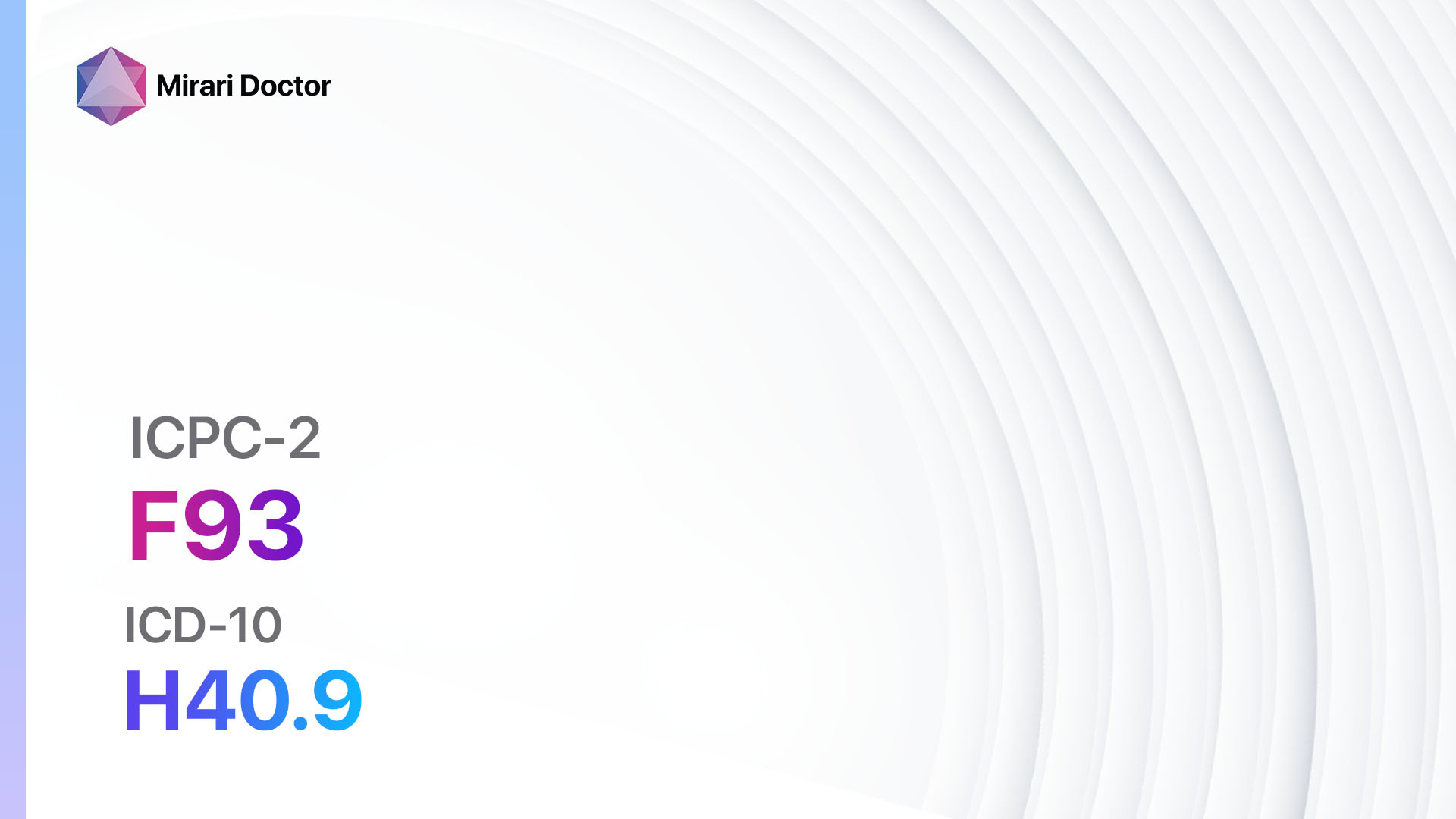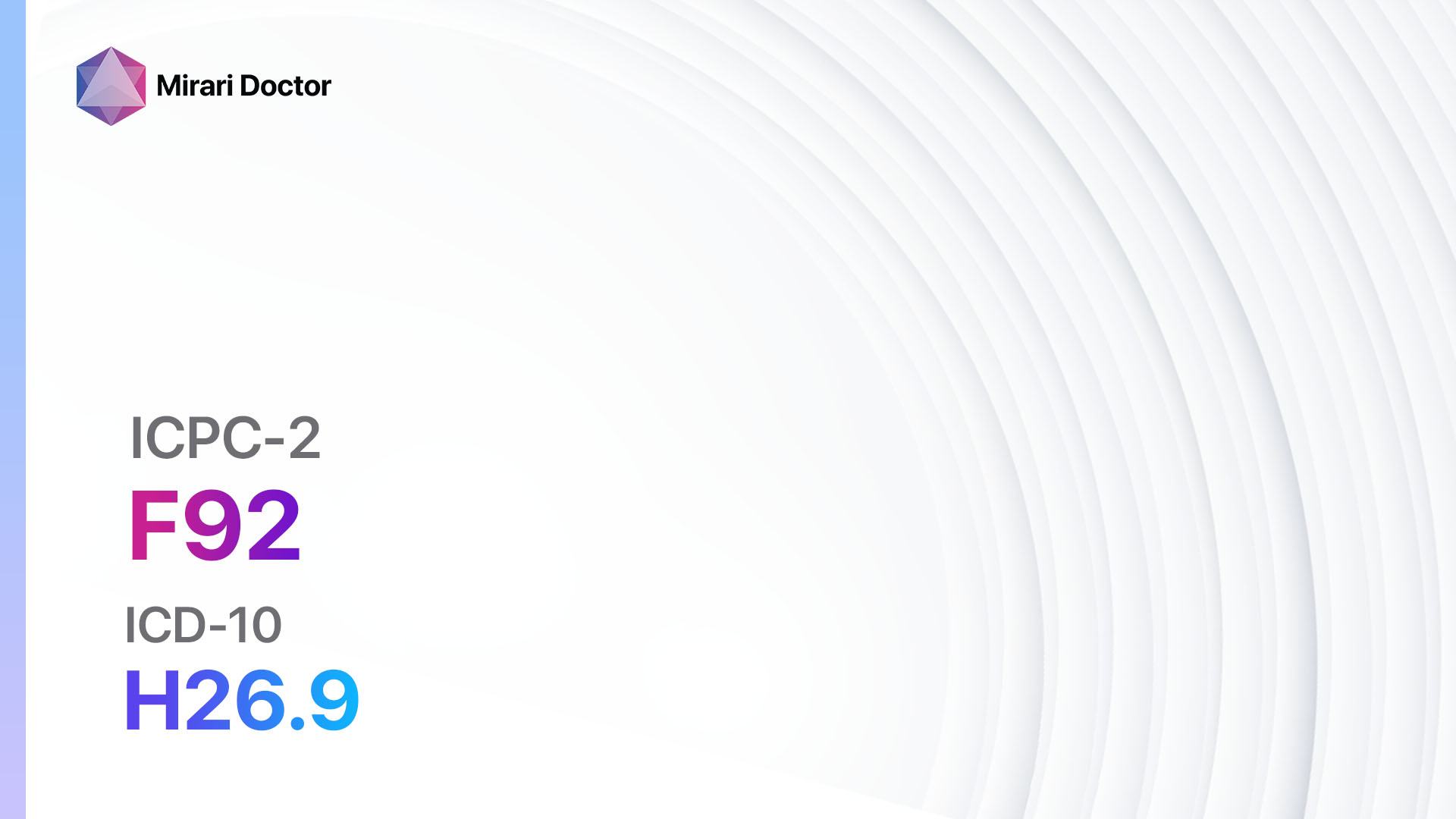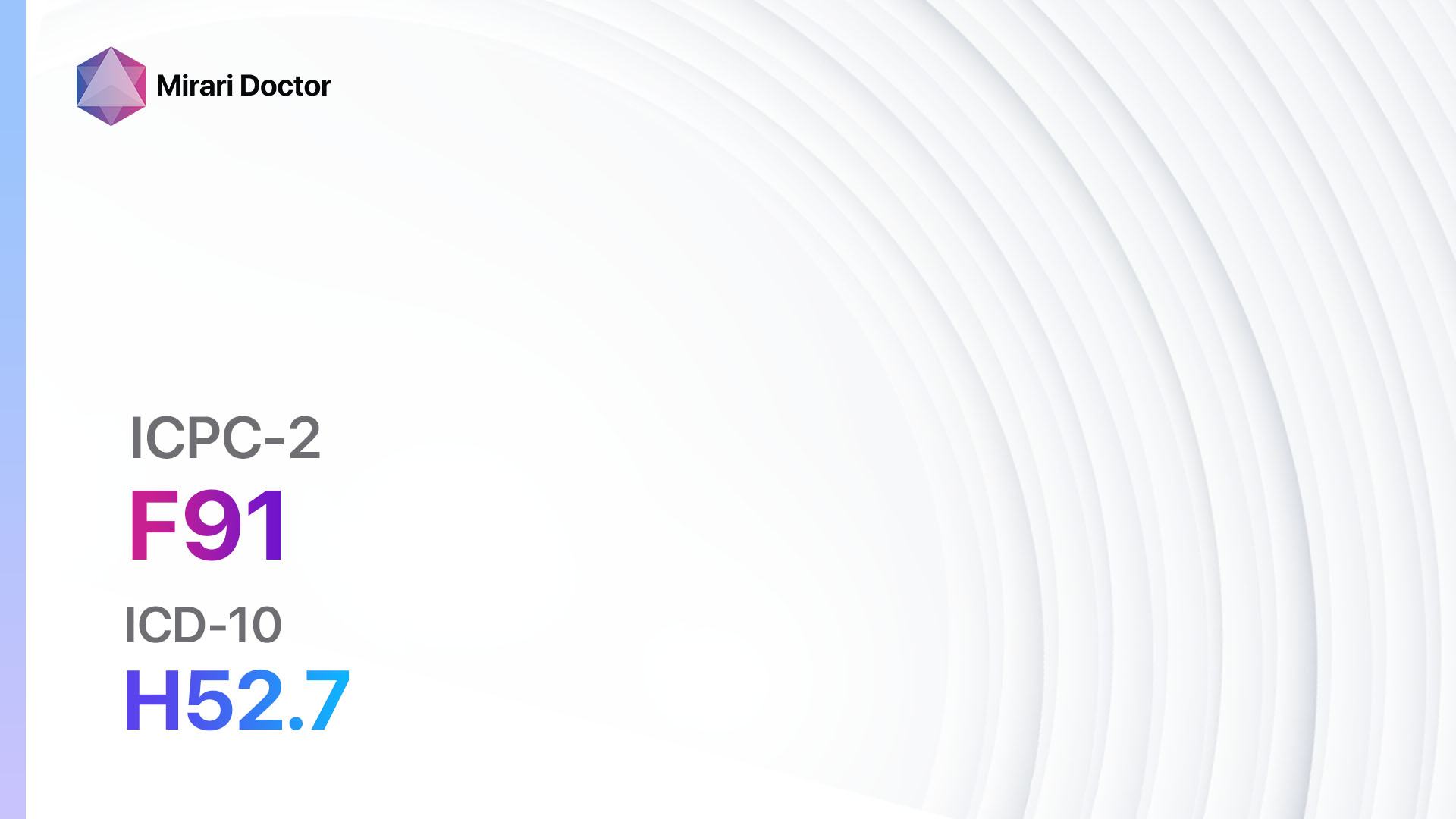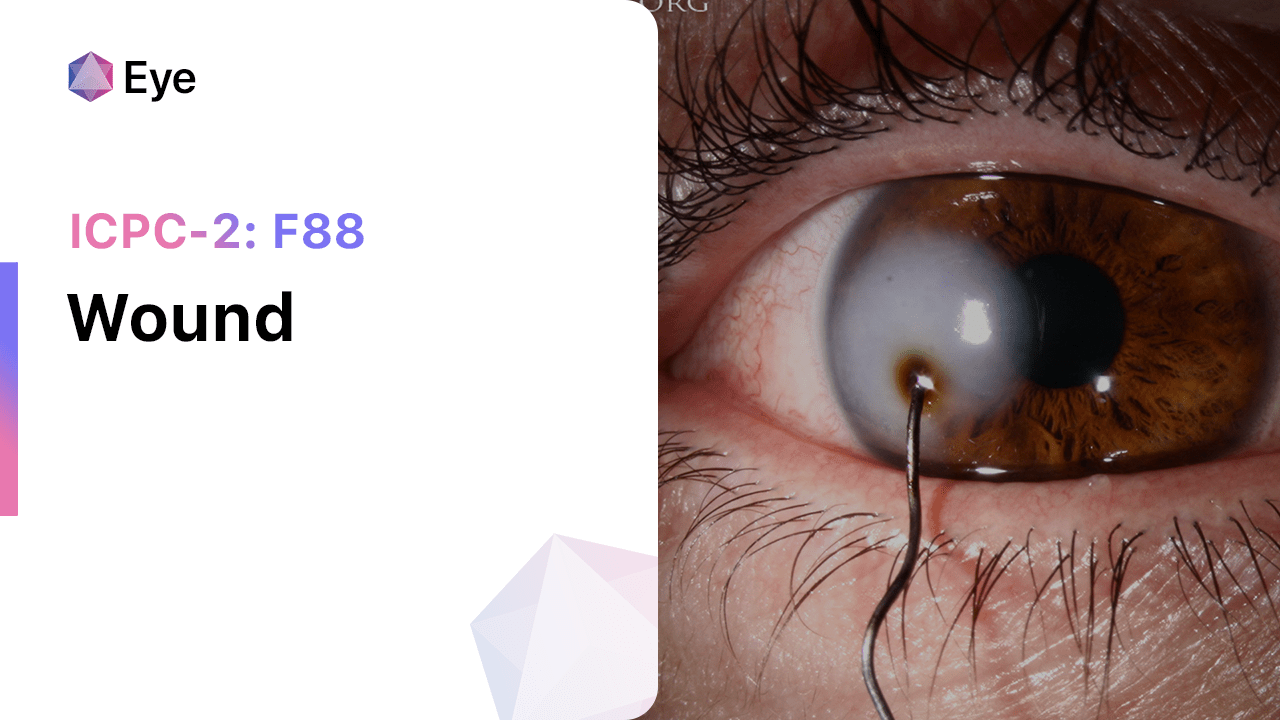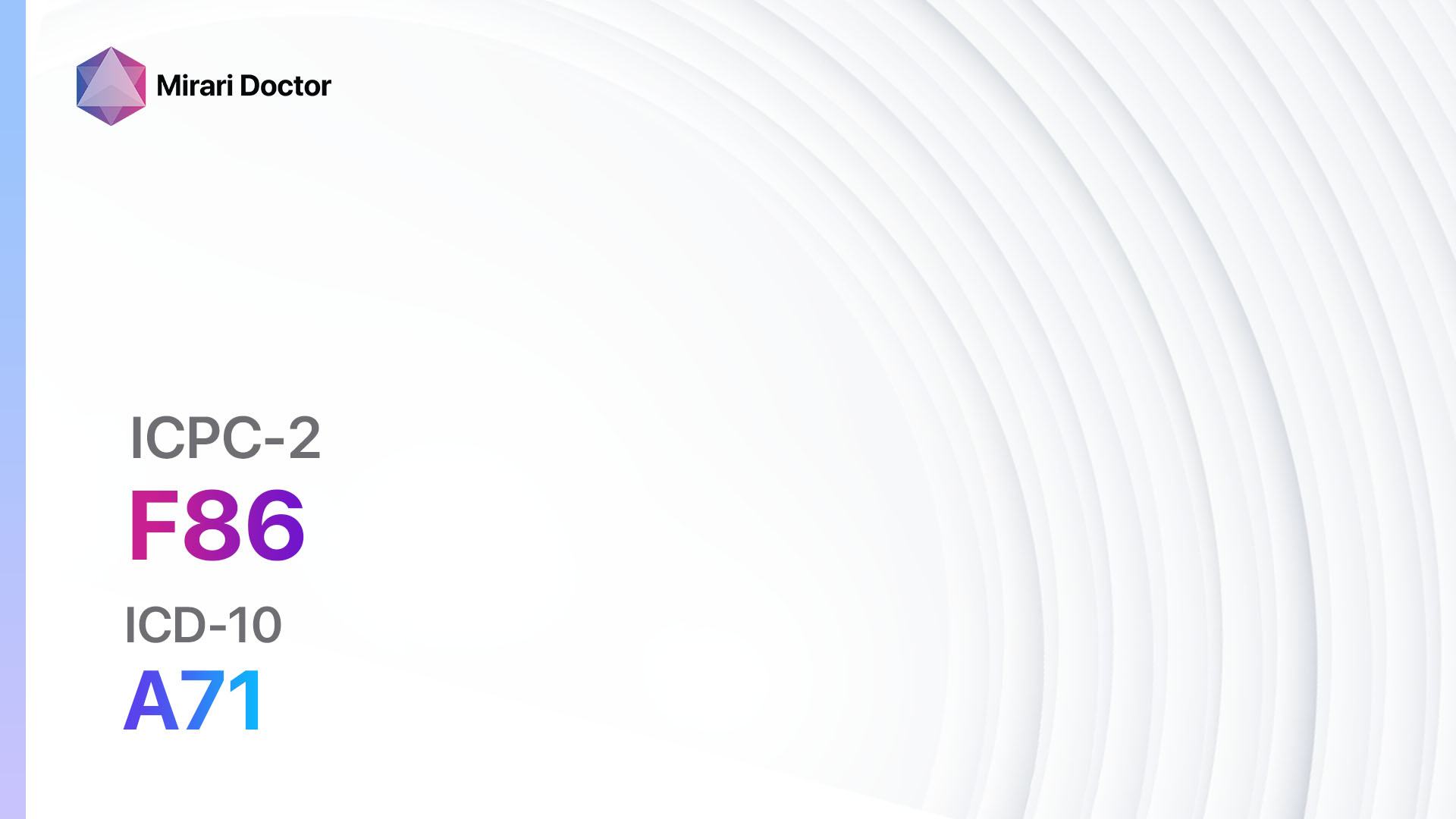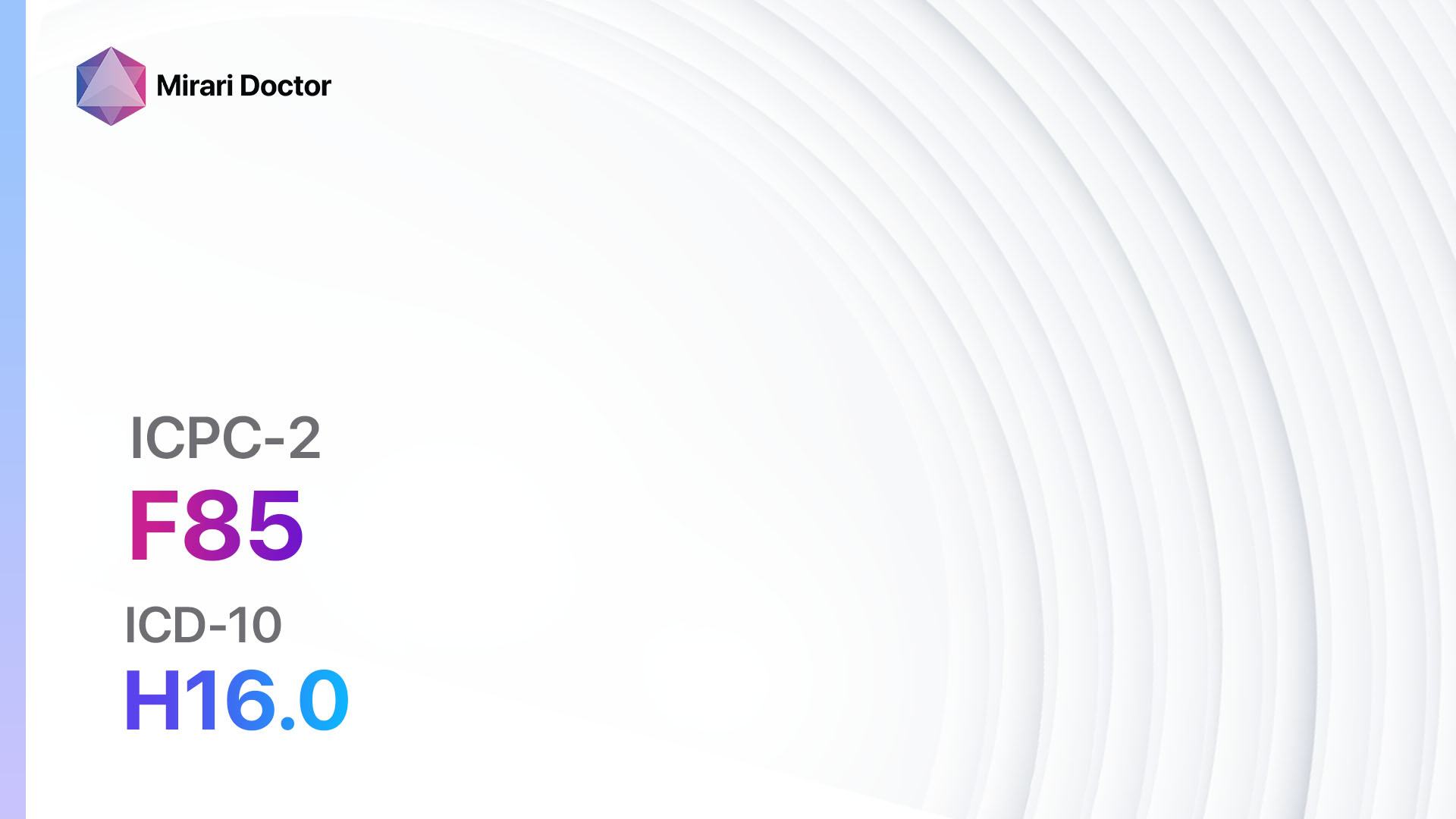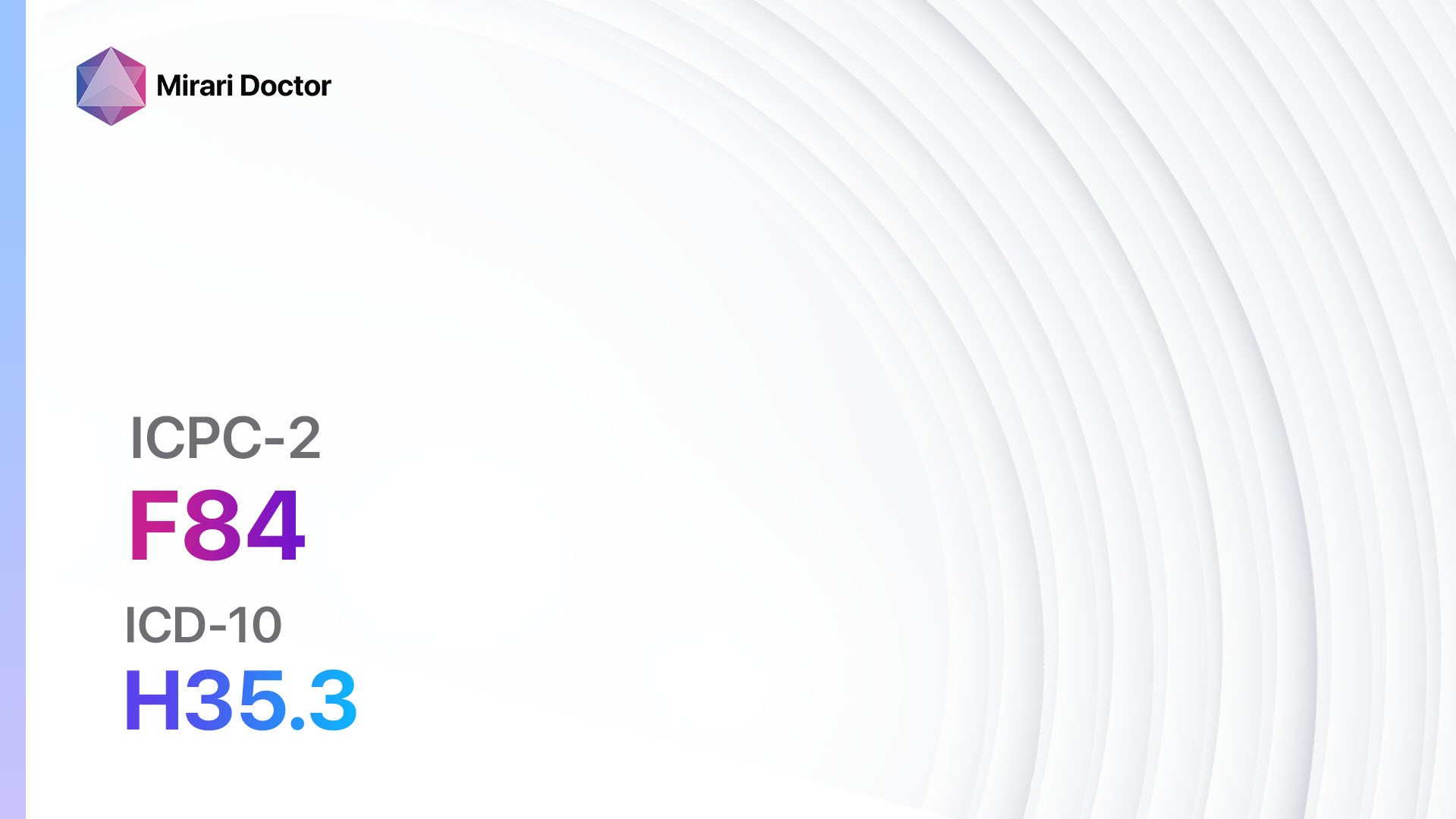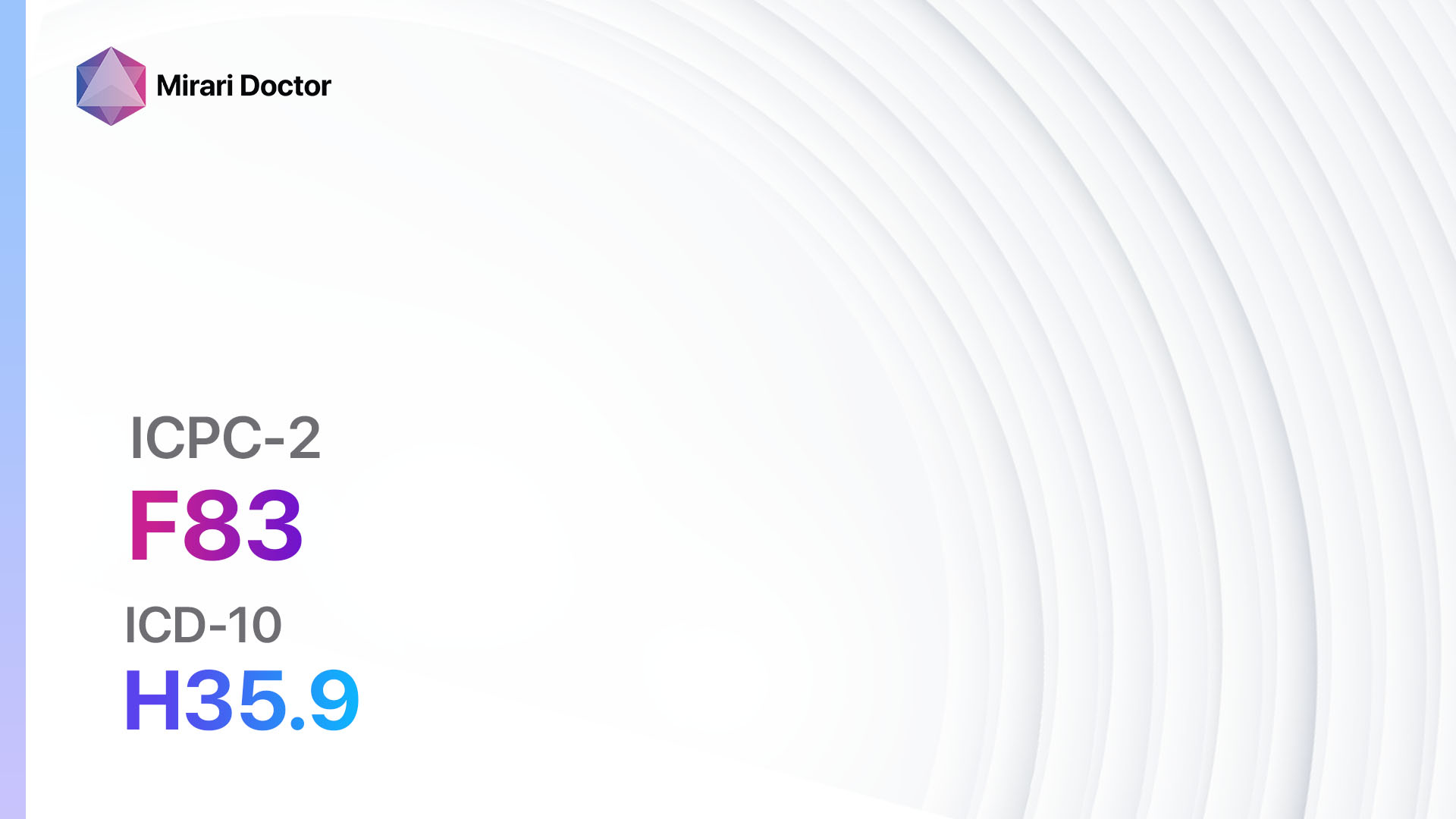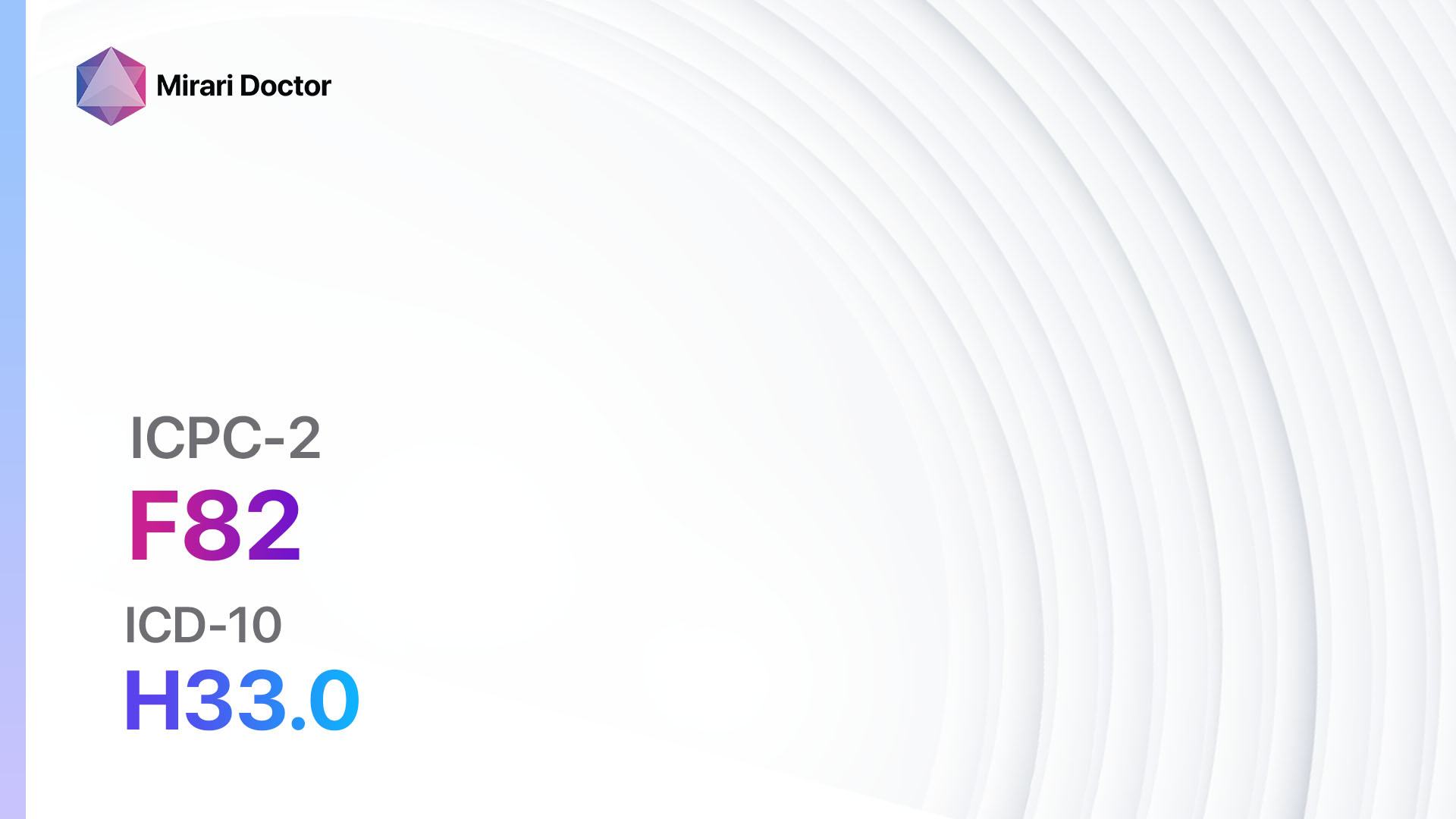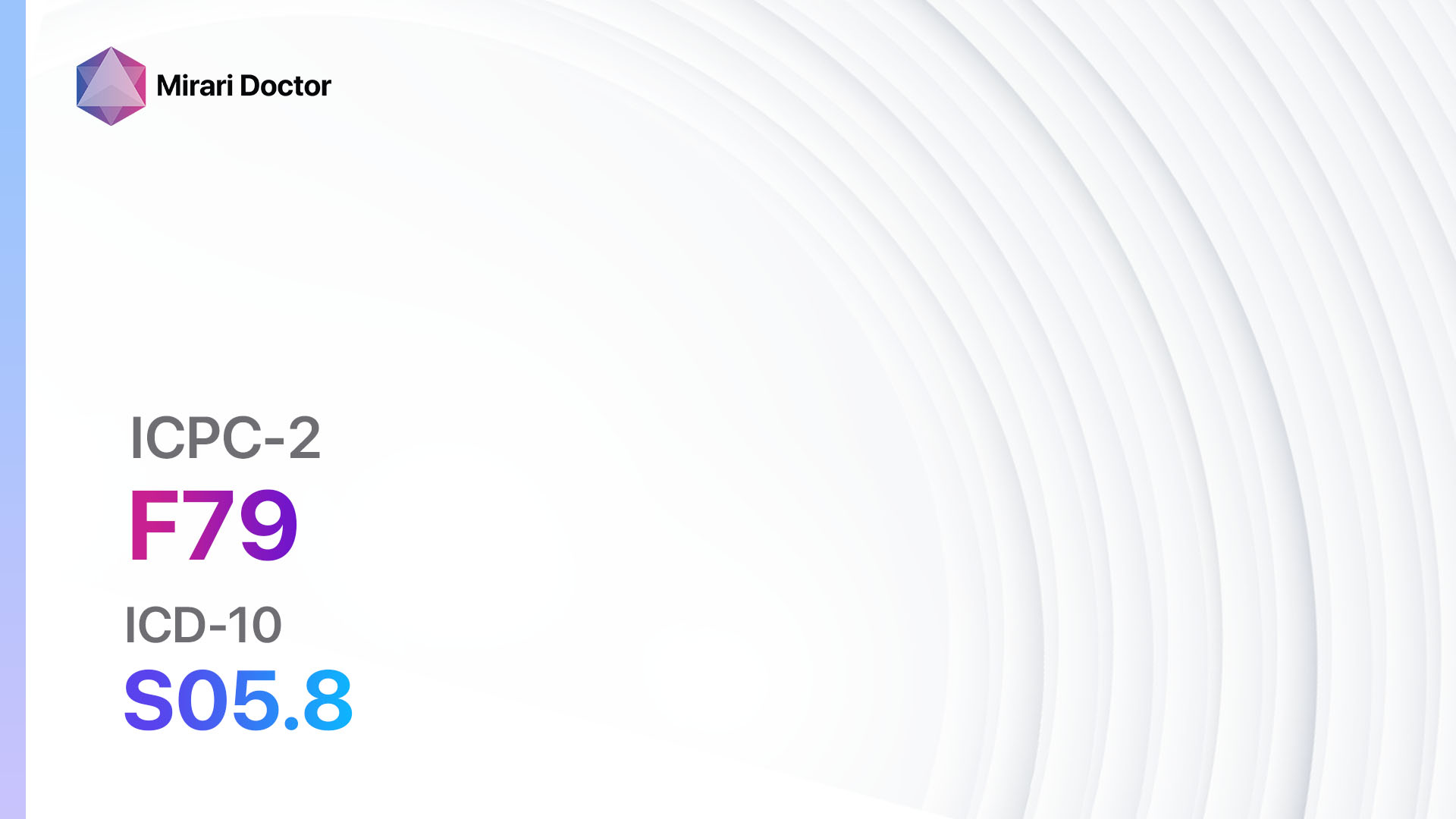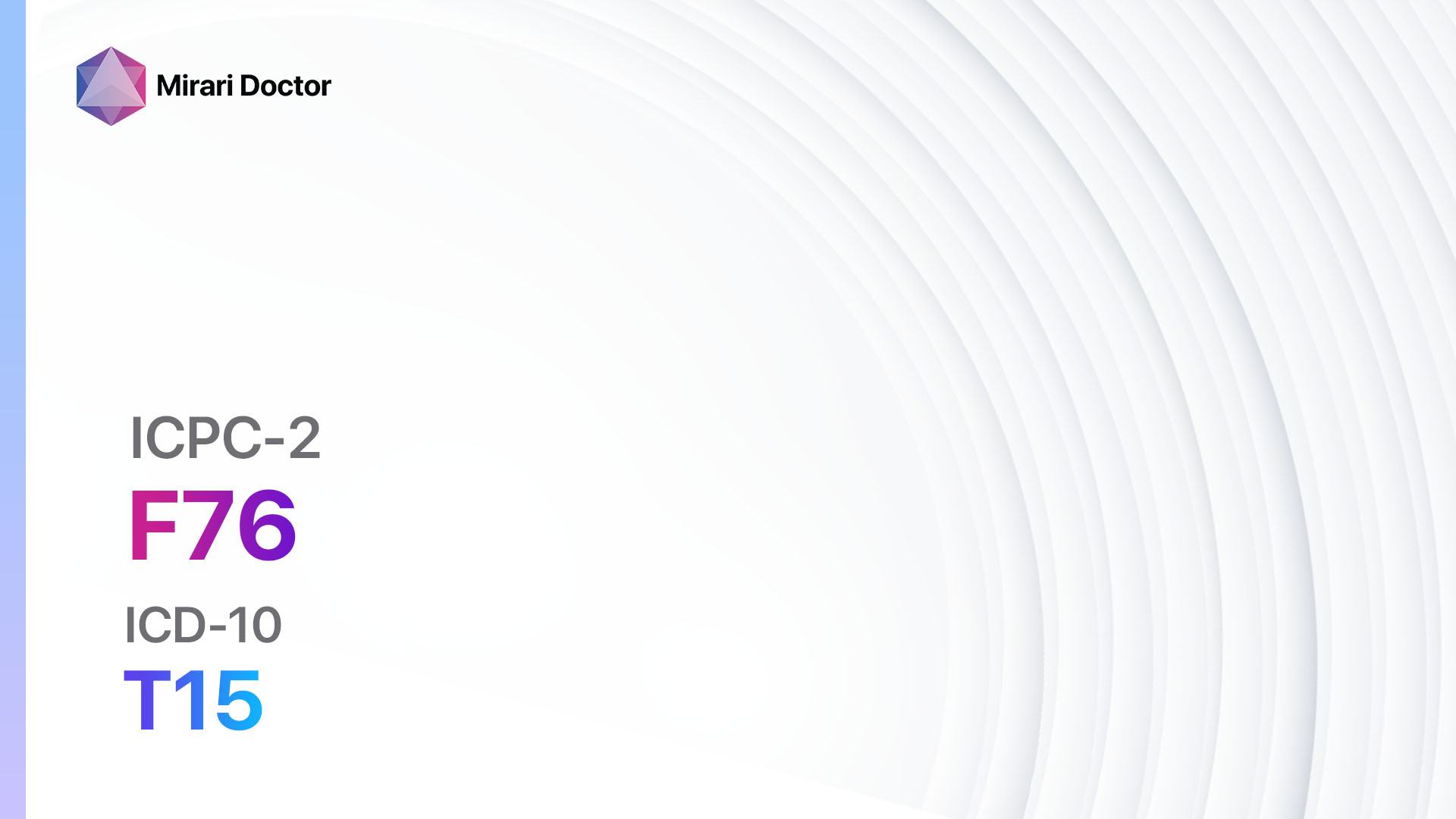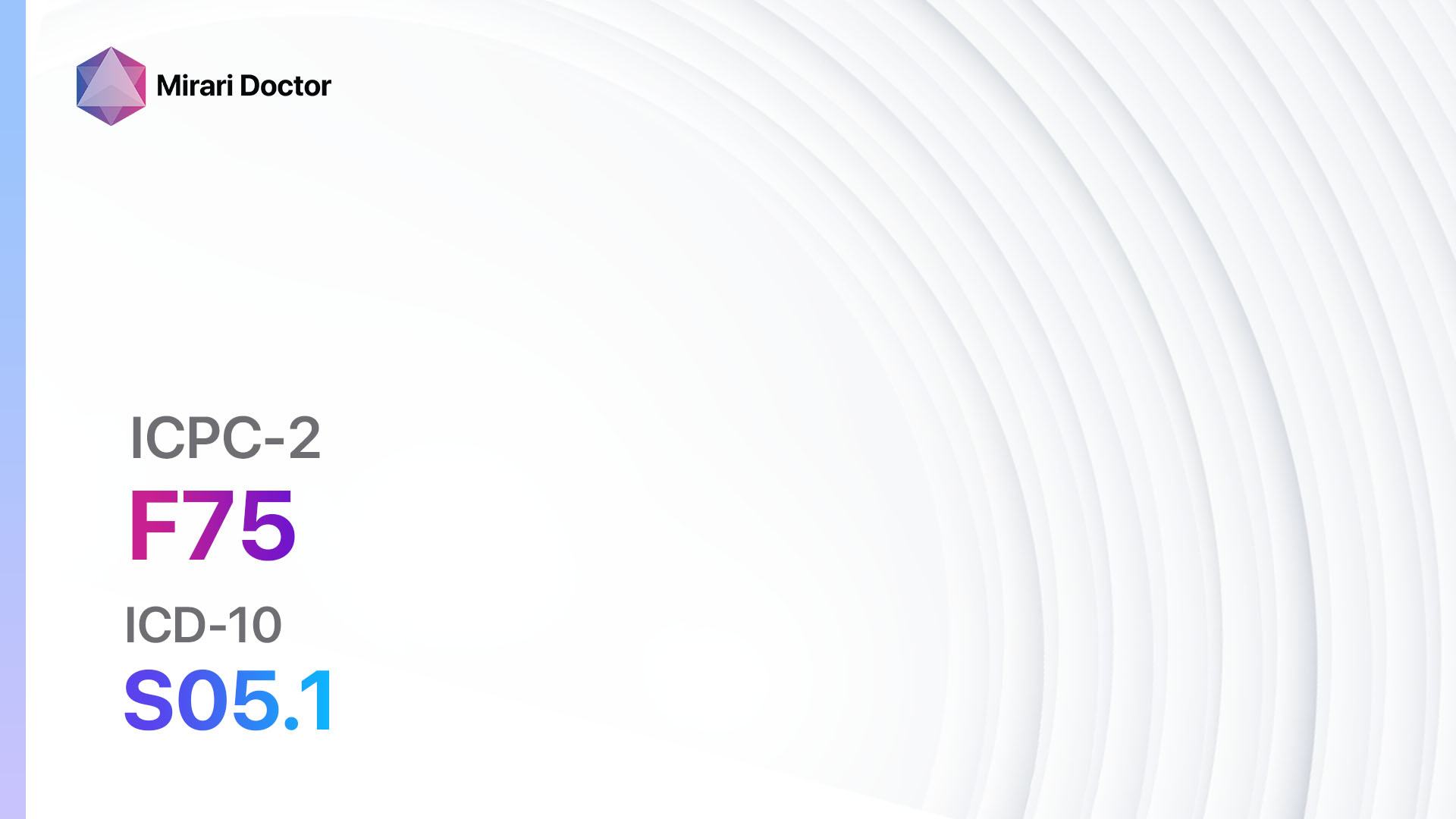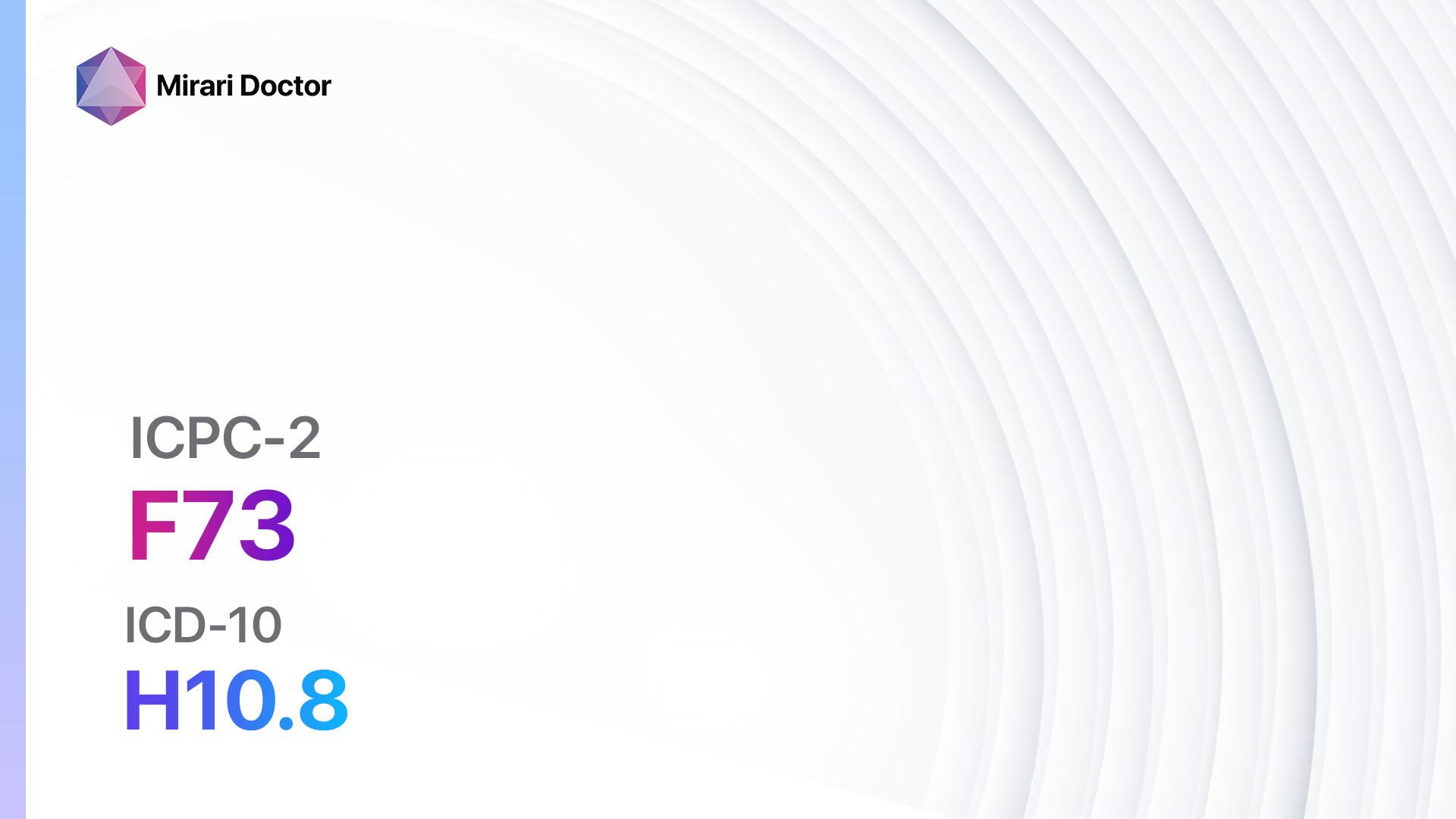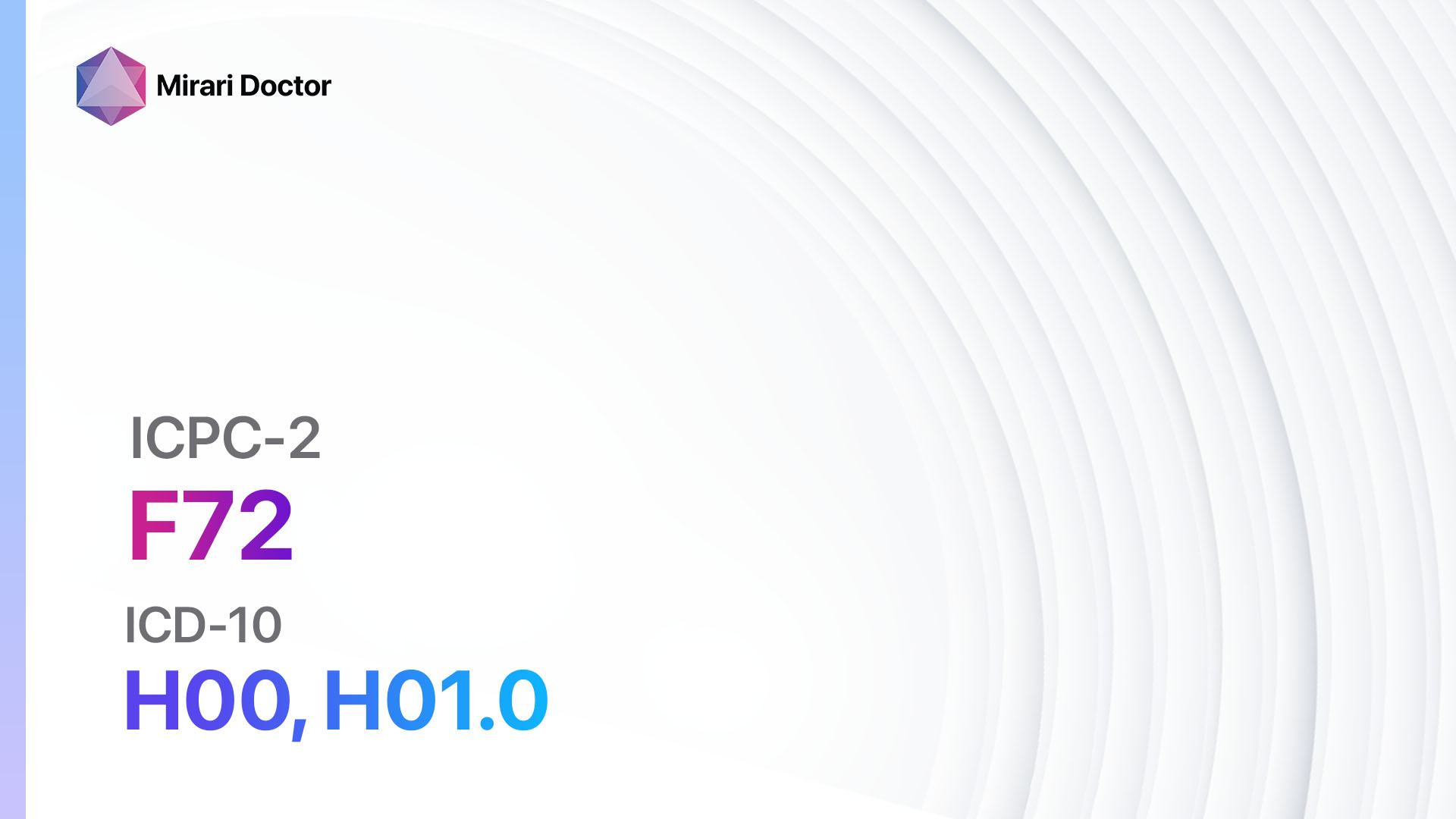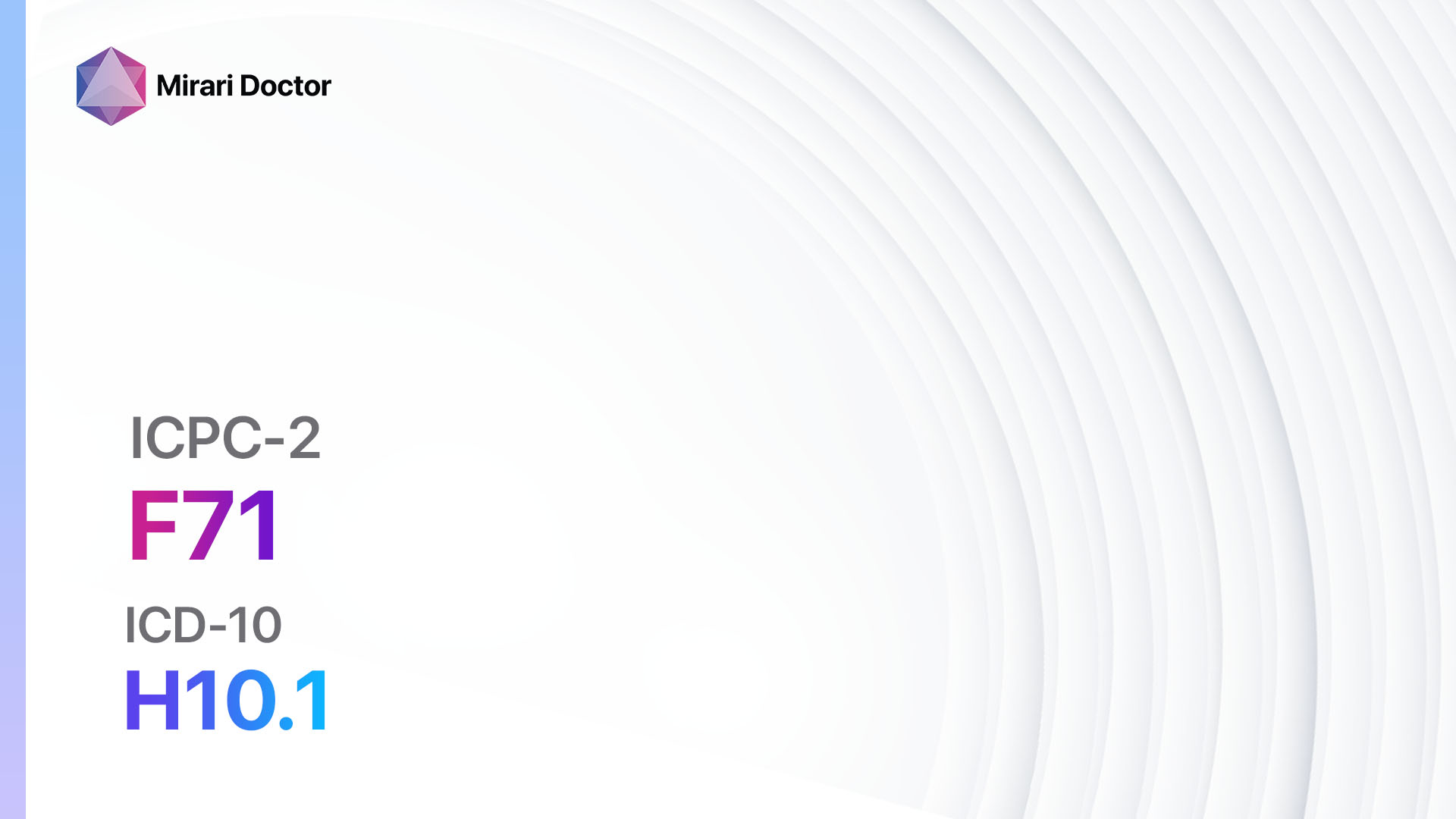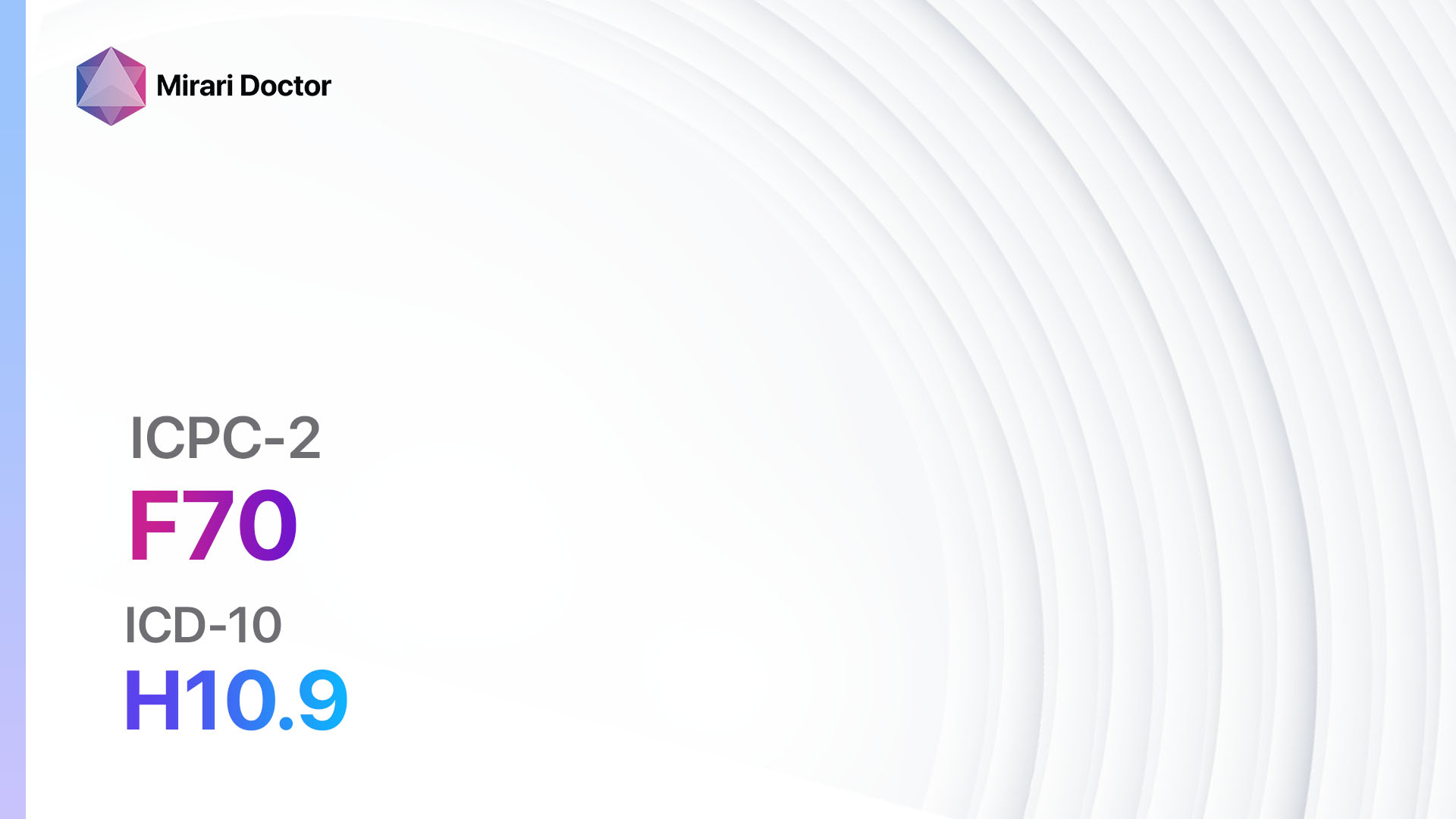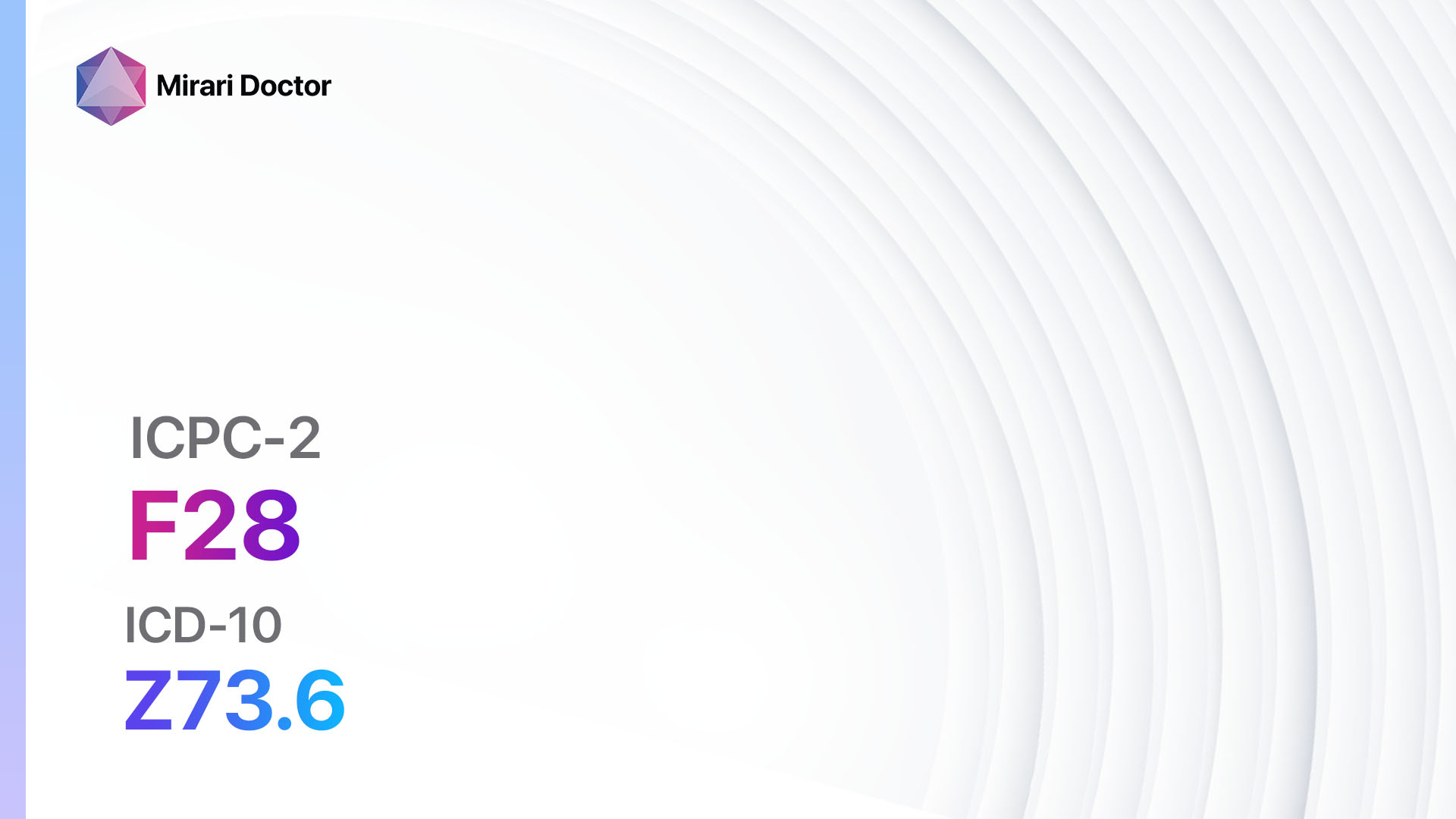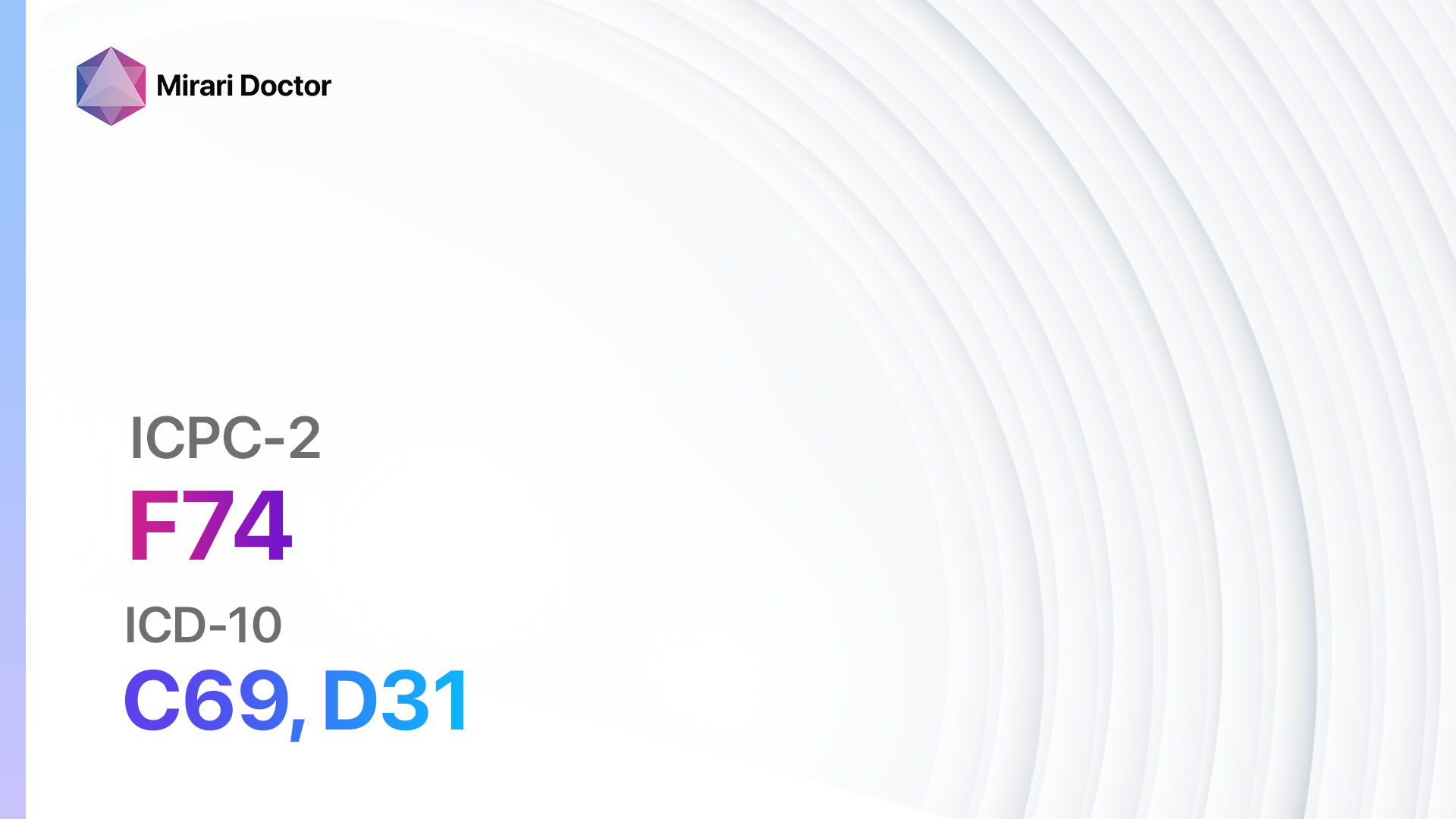
Introduction
Neoplasm of the eye/adnexa refers to the development of abnormal growths or tumors in the eye or its surrounding structures. These tumors can be benign or malignant and can affect various parts of the eye, including the eyelids, conjunctiva, cornea, iris, ciliary body, choroid, retina, and optic nerve.[1] The aim of this guide is to provide an overview of the symptoms, causes, diagnostic steps, possible interventions, and patient education related to neoplasm of the eye/adnexa.
Codes
- ICPC-2 Code: F74 Neoplasm of eye/adnexa[2]
- ICD-10 Code: C69 Malignant neoplasm of eye and adnexa, D31 Benign neoplasm of eye and adnexa[3],[4]
Symptoms
- Eye pain: Patients may experience pain or discomfort in the affected eye.[5]
- Vision changes: Blurred vision, double vision, or loss of vision may occur.[6]
- Eye redness: The eye may appear red or bloodshot.[7]
- Eyelid swelling: Swelling of the eyelids may be present.[8]
- Eye discharge: Patients may notice discharge or excessive tearing from the affected eye.[9]
- Sensitivity to light: Increased sensitivity to light may be observed.[10]
- Bulging of the eye: In some cases, the eye may appear to be bulging outwards.
- Changes in the appearance of the eye: The affected eye may have a change in color or shape.
Causes
- Genetic factors: Certain genetic mutations or inherited conditions may increase the risk of developing neoplasms of the eye/adnexa.
- Exposure to UV radiation: Prolonged exposure to sunlight or artificial sources of UV radiation may contribute to the development of eye tumors.
- Age: The risk of developing neoplasms of the eye/adnexa increases with age.
- Previous eye trauma: Individuals who have experienced previous eye injuries or trauma may be at a higher risk.
- Immunodeficiency: Patients with weakened immune systems, such as those with HIV/AIDS or undergoing immunosuppressive therapy, may have an increased risk.
Diagnostic Steps
Medical History
- Gather information about the patient’s symptoms, including the duration and progression of symptoms.
- Assess the patient’s medical history, including any previous eye conditions, surgeries, or trauma.
- Inquire about any family history of eye tumors or other related conditions.
- Determine if the patient has any risk factors, such as exposure to UV radiation or a weakened immune system.
Physical Examination
- Perform a comprehensive eye examination, including visual acuity testing, assessment of eye movements, and examination of the eyelids, conjunctiva, cornea, iris, and retina.
- Evaluate the size, shape, and color of any visible tumors or growths.
- Palpate the eye and surrounding structures to check for tenderness or abnormalities.
- Assess the patient’s visual field and pupillary reflexes.
Laboratory Tests
- Blood tests: These may be done to assess general health, rule out other systemic conditions, or evaluate tumor markers.
- Biopsy: A sample of the tumor or growth may be taken for further analysis to determine if it is benign or malignant.
Diagnostic Imaging
- Ultrasound: This imaging modality can help visualize the internal structures of the eye and assess the size and location of tumors.
- Magnetic Resonance Imaging (MRI): MRI scans can provide detailed images of the eye and surrounding structures, helping to determine the extent of the tumor and its relationship to nearby tissues.
- Computed Tomography (CT) scan: CT scans can provide cross-sectional images of the eye and help identify any bony involvement or spread of the tumor.
- Fluorescein angiography: This test involves injecting a dye into the bloodstream to evaluate blood flow in the retina and identify any abnormal blood vessels.
Other Tests
- Visual field testing: This test assesses the patient’s peripheral vision and can help detect any visual field defects caused by the tumor.
- Electroretinography (ERG): ERG measures the electrical activity of the retina and can help assess retinal function.
- Optical coherence tomography (OCT): OCT uses light waves to create detailed cross-sectional images of the retina, helping to evaluate the thickness and integrity of retinal layers.
Follow-up and Patient Education
- Schedule regular follow-up appointments to monitor the progression of the tumor and assess treatment effectiveness.
- Educate the patient about the importance of regular eye examinations and early detection of any changes in vision or eye health.
- Provide information about support groups or resources available for patients with eye tumors.
- Discuss the potential complications and prognosis associated with the specific type and stage of the tumor.
Possible Interventions
Traditional Interventions
Medications:
Top 5 drugs for Neoplasm of eye/adnexa:
- Chemotherapy agents (e.g., Cisplatin, Carboplatin):
- Cost: Varies depending on the specific drug and treatment regimen.
- Contraindications: Severe kidney or liver dysfunction, hearing loss.
- Side effects: Nausea, vomiting, hair loss, fatigue.
- Severe side effects: Bone marrow suppression, kidney damage, nerve damage.
- Drug interactions: Other nephrotoxic drugs, ototoxic drugs.
- Warning: Regular monitoring of blood counts and kidney function required.
- Targeted therapy (e.g., Bevacizumab, Trastuzumab):
- Cost: Varies depending on the specific drug and treatment regimen.
- Contraindications: Hypersensitivity to the drug, severe heart disease.
- Side effects: Fatigue, diarrhea, high blood pressure.
- Severe side effects: Bleeding, heart failure, infusion reactions.
- Drug interactions: Other drugs that affect blood clotting, certain chemotherapy agents.
- Warning: Regular monitoring of blood pressure and heart function required.
- Immunotherapy (e.g., Pembrolizumab, Nivolumab):
- Cost: Varies depending on the specific drug and treatment regimen.
- Contraindications: Severe autoimmune disease, organ transplant.
- Side effects: Fatigue, skin rash, diarrhea.
- Severe side effects: Immune-related adverse events, pneumonitis, colitis.
- Drug interactions: Other immunosuppressive drugs, certain chemotherapy agents.
- Warning: Regular monitoring of immune function and organ toxicity required.
- Radiation therapy:
- Cost: Varies depending on the specific treatment plan and duration.
- Contraindications: Pregnancy, severe underlying medical conditions.
- Side effects: Fatigue, skin changes, dry eyes.
- Severe side effects: Radiation retinopathy, radiation optic neuropathy.
- Drug interactions: None.
- Warning: Regular monitoring of eye health and potential long-term complications required.
- Surgery (e.g., Enucleation, Orbital exenteration):
- Cost: Varies depending on the specific procedure and healthcare provider.
- Contraindications: Severe underlying medical conditions, high surgical risk.
- Side effects: Pain, swelling, bleeding.
- Severe side effects: Infection, damage to surrounding structures, loss of vision.
- Drug interactions: None.
- Warning: Post-operative care and regular follow-up required.
Alternative Drugs:
- Photodynamic therapy (PDT): Uses a photosensitizing agent and light to destroy cancer cells. Cost: Varies depending on the specific treatment plan.
- Cryotherapy: Freezing the tumor to destroy abnormal cells. Cost: Varies depending on the specific treatment plan.
- Laser therapy: Uses a focused beam of light to destroy or shrink tumors. Cost: Varies depending on the specific treatment plan.
- Intra-arterial chemotherapy: Delivers chemotherapy drugs directly into the blood vessels supplying the tumor. Cost: Varies depending on the specific treatment plan.
- Orbital radiation therapy: Delivers radiation to the eye and surrounding structures to destroy cancer cells. Cost: Varies depending on the specific treatment plan.
Surgical Procedures:
- Enucleation: Removal of the entire eyeball. Cost: Varies depending on the healthcare provider and location.
- Orbital exenteration: Removal of the entire contents of the eye socket, including the eyeball, eyelids, and surrounding tissues. Cost: Varies depending on the healthcare provider and location.
- Eyelid surgery: Removal of the tumor and reconstruction of the eyelid. Cost: Varies depending on the specific procedure and healthcare provider.
- Conjunctival surgery: Removal of the tumor from the conjunctiva and reconstruction of the affected area. Cost: Varies depending on the specific procedure and healthcare provider.
- Lacrimal gland surgery: Removal of the tumor from the lacrimal gland. Cost: Varies depending on the specific procedure and healthcare provider.
Alternative Interventions
- Acupuncture: May help alleviate pain and improve overall well-being. Cost: $60-$120 per session.
- Herbal supplements: Some herbal supplements, such as turmeric or green tea extract, may have potential anti-cancer properties. Cost: Varies depending on the specific supplement.
- Mind-body techniques: Practices like meditation, yoga, or guided imagery may help reduce stress and improve quality of life. Cost: Varies depending on the specific practice and location.
- Nutritional therapy: A balanced diet rich in fruits, vegetables, and whole grains may support overall health and immune function. Cost: Varies depending on individual dietary choices.
- Homeopathy: Some homeopathic remedies may be used to support the body’s natural healing processes. Cost: Varies depending on the specific remedy and provider.
Lifestyle Interventions
- Sun protection: Encourage patients to wear sunglasses and hats to protect their eyes from UV radiation.
- Smoking cessation: Advise patients to quit smoking, as smoking is a known risk factor for eye tumors.
- Healthy diet: Promote a diet rich in fruits, vegetables, and omega-3 fatty acids to support overall eye health.
- Regular exercise: Encourage patients to engage in regular physical activity to maintain a healthy weight and promote overall well-being.
- Stress management: Recommend stress-reducing techniques, such as mindfulness or relaxation exercises, to improve overall quality of life.
It is important to note that the cost ranges provided are approximate and may vary depending on the location and availability of the interventions. Patients should consult with their healthcare provider to determine the most appropriate interventions for their specific condition.
Mirari Cold Plasma Alternative Intervention
Understanding Mirari Cold Plasma
- Safe and Non-Invasive Treatment: Mirari Cold Plasma is a safe and non-invasive treatment option for various skin conditions. It does not require incisions, minimizing the risk of scarring, bleeding, or tissue damage.
- Efficient Extraction of Foreign Bodies: Mirari Cold Plasma facilitates the removal of foreign bodies from the skin by degrading and dissociating organic matter, allowing easier access and extraction.
- Pain Reduction and Comfort: Mirari Cold Plasma has a local analgesic effect, providing pain relief during the treatment, making it more comfortable for the patient.
- Reduced Risk of Infection: Mirari Cold Plasma has antimicrobial properties, effectively killing bacteria and reducing the risk of infection.
- Accelerated Healing and Minimal Scarring: Mirari Cold Plasma stimulates wound healing and tissue regeneration, reducing healing time and minimizing the formation of scars.
Mirari Cold Plasma Prescription
Video instructions for using Mirari Cold Plasma Device – F74 Neoplasm of eye/adnexa (ICD-10:C69, D31)
| Mild | Moderate | Severe |
| Mode setting: 1 (Infection) Location: 7 (Neuro system & ENT) Morning: 15 minutes, Evening: 15 minutes |
Mode setting: 1 (Infection) Location: 7 (Neuro system & ENT) Morning: 30 minutes, Lunch: 30 minutes, Evening: 30 minutes |
Mode setting: 1 (Infection) Location: 7 (Neuro system & ENT) Morning: 30 minutes, Lunch: 30 minutes, Evening: 30 minutes |
| Mode setting: 2 (Wound Healing) Location: 7 (Neuro system & ENT) Morning: 15 minutes, Evening: 15 minutes |
Mode setting: 2 (Wound Healing) Location: 7 (Neuro system & ENT) Morning: 30 minutes, Lunch: 30 minutes, Evening: 30 minutes |
Mode setting: 2 (Wound Healing) Location: 7 (Neuro system & ENT) Morning: 30 minutes, Lunch: 30 minutes, Evening: 30 minutes |
| Mode setting: 3 (Antiviral Therapy) Location: 7 (Neuro system & ENT) Morning: 15 minutes, Evening: 15 minutes |
Mode setting: 3 (Antiviral Therapy) Location: 7 (Neuro system & ENT) Morning: 30 minutes, Lunch: 30 minutes, Evening: 30 minutes |
Mode setting: 3 (Antiviral Therapy) Location: 7 (Neuro system & ENT) Morning: 30 minutes, Lunch: 30 minutes, Evening: 30 minutes |
| Total Morning: 45 minutes approx. $7.50 USD, Evening: 45 minutes approx. $7.50 USD |
Total Morning: 90 minutes approx. $15 USD, Lunch: 90 minutes approx. $15 USD, Evening: 90 minutes approx. $15 USD, |
Total Morning: 90 minutes approx. $15 USD, Lunch: 90 minutes approx. $15 USD, Evening: 90 minutes approx. $15 USD, |
| Usual treatment for 7-60 days approx. $105 USD – $900 USD | Usual treatment for 6-8 weeks approx. $1,890 USD – $2,520 USD |
Usual treatment for 3-6 months approx. $4,050 USD – $8,100 USD
|
 |
|
Use the Mirari Cold Plasma device to treat Neoplasm of eye/adnexa effectively.
WARNING: MIRARI COLD PLASMA IS DESIGNED FOR THE HUMAN BODY WITHOUT ANY ARTIFICIAL OR THIRD PARTY PRODUCTS. USE OF OTHER PRODUCTS IN COMBINATION WITH MIRARI COLD PLASMA MAY CAUSE UNPREDICTABLE EFFECTS, HARM OR INJURY. PLEASE CONSULT A MEDICAL PROFESSIONAL BEFORE COMBINING ANY OTHER PRODUCTS WITH USE OF MIRARI.
Step 1: Cleanse the Skin
- Start by cleaning the affected area of the skin with a gentle cleanser or mild soap and water. Gently pat the area dry with a clean towel.
Step 2: Prepare the Mirari Cold Plasma device
- Ensure that the Mirari Cold Plasma device is fully charged or has fresh batteries as per the manufacturer’s instructions. Make sure the device is clean and in good working condition.
- Switch on the Mirari device using the power button or by following the specific instructions provided with the device.
- Some Mirari devices may have adjustable settings for intensity or treatment duration. Follow the manufacturer’s instructions to select the appropriate settings based on your needs and the recommended guidelines.
Step 3: Apply the Device
- Place the Mirari device in direct contact with the affected area of the skin. Gently glide or hold the device over the skin surface, ensuring even coverage of the area experiencing.
- Slowly move the Mirari device in a circular motion or follow a specific pattern as indicated in the user manual. This helps ensure thorough treatment coverage.
Step 4: Monitor and Assess:
- Keep track of your progress and evaluate the effectiveness of the Mirari device in managing your Neoplasm of eye/adnexa. If you have any concerns or notice any adverse reactions, consult with your health care professional.
Note
This guide is for informational purposes only and should not replace the advice of a medical professional. Always consult with your healthcare provider or a qualified medical professional for personal advice, diagnosis, or treatment. Do not solely rely on the information presented here for decisions about your health. Use of this information is at your own risk. The authors of this guide, nor any associated entities or platforms, are not responsible for any potential adverse effects or outcomes based on the content.
Mirari Cold Plasma System Disclaimer
- Purpose: The Mirari Cold Plasma System is a Class 2 medical device designed for use by trained healthcare professionals. It is registered for use in Thailand and Vietnam. It is not intended for use outside of these locations.
- Informational Use: The content and information provided with the device are for educational and informational purposes only. They are not a substitute for professional medical advice or care.
- Variable Outcomes: While the device is approved for specific uses, individual outcomes can differ. We do not assert or guarantee specific medical outcomes.
- Consultation: Prior to utilizing the device or making decisions based on its content, it is essential to consult with a Certified Mirari Tele-Therapist and your medical healthcare provider regarding specific protocols.
- Liability: By using this device, users are acknowledging and accepting all potential risks. Neither the manufacturer nor the distributor will be held accountable for any adverse reactions, injuries, or damages stemming from its use.
- Geographical Availability: This device has received approval for designated purposes by the Thai and Vietnam FDA. As of now, outside of Thailand and Vietnam, the Mirari Cold Plasma System is not available for purchase or use.
References
- Domingo, R. E. D., Manganip, L. E., & Castro, R. M. (2015). Tumors of the eye and ocular adnexa at the Philippine Eye Research Institute: a 10-year review. Clinical Ophthalmology, 9, 1239–1247. https://doi.org/10.2147/OPTH.S87308
- World Health Organization. (2022). International Classification of Primary Care (ICPC-2). https://www.who.int/standards/classifications/other-classifications/international-classification-of-primary-care
- Centers for Disease Control and Prevention. (2022). ICD-10-CM Code C69: Malignant neoplasm of eye and adnexa. https://icd.codes/icd10cm/C69
- Centers for Disease Control and Prevention. (2022). ICD-10-CM Code D31: Benign neoplasm of eye and adnexa. https://icd.codes/icd10cm/D31
- American Academy of Ophthalmology. (2022). Eye Cancer Symptoms. https://www.aao.org/eye-health/diseases/eye-cancer-symptoms
- National Eye Institute. (2022). Eye Cancer. https://www.nei.nih.gov/learn-about-eye-health/eye-conditions-and-diseases/eye-cancer
- Cancer Research UK. (2022). Eye Cancer Symptoms. https://www.cancerresearchuk.org/about-cancer/eye-cancer/symptoms
- American Cancer Society. (2022). Signs and Symptoms of Eye Cancer. https://www.cancer.org/cancer/eye-cancer/detection-diagnosis-staging/signs-and-symptoms.html
- Mayo Clinic. (2022). Eye Cancer. https://www.mayoclinic.org/diseases-conditions/eye-cancer/symptoms-causes/syc-20351104
- National Health Service. (2022). Eye Cancer. https://www.nhs.uk/conditions/eye-cancer/
Related articles
Made in USA





